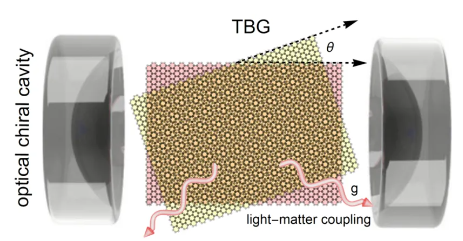Release date:2024-04-22
Page views:79
The twisted bilayer graphene (TBG) system is one of the important discoveries in condensed matter physics in recent years. It has become an extremely rich platform for studying quantum many-body physics. Especially at a specific twist angle, the so-called "magic angle" (approximately 1.05 degrees), TBG undergoes a superconducting phase transition. Although the origin of exotic superconductivity in TBG remains a controversial topic, it is generally believed that the flat-band effect plays an essential role. However, since TBG is not a stable configuration at the magic angle, it is often difficult to accurately prepare magic-angle graphene experimentally. Experiments have observed that when the twist angle deviates from the magic angle by 0.1 degrees, the superconducting phase disappears. This instability has limited extensive research on superconducting properties in TBG.In this study, the researchers proposed a new method, namely, using quantum fluctuations in a chiral microcavity to engineer the band structure of TBG, so that TBG can form a flat band beyond the magic angle (see Figure 1)[1]. The physical picture is that the chiral microcavity breaks time-reversal symmetry, and the vacuum quantum fluctuations in the cavity inherit the characteristics of time-reversal symmetry breaking. The time-reversal symmetry broken quantum fluctuations can induce energy gaps in the band structure, leading to a significant impact on the band flatness near the magic angle. By controlling the effective mode volume of the chiral microcavity, one can effectively tune the coupling strength of electron-photon interaction, achieving precise control of the band structure and even topological properties of the system. This work is based on the previous studies on the quantum atmospheric effect [2] and the chiral vacuum molecule selection effect [3].

Figure 1:Schematic setup of using vacuum quantum fluctuations in chiral optical microcavities to engineer TBG band structure. The method of using vacuum microcavities to control quantum materials can avoid non-equilibrium processes and material heating effects that may be caused by traditional optical methods, and achieve new quantum states matter that cannot be achieved by classical electromagnetic radiation.
This first author of this work is Jiang Cunyuan, a graduate student in the School of Physics and Astronomy of Shanghai Jiao Tong University. Associate Professor Matteo Baggioli of the School of Physics and Astronomy and Associate Professor Qingdong Jiang of the Tsung-Dao Lee Institute are the co-corresponding authors [1]. This research was funded by the Shanghai Municipal Science and Technology Major Project, Innovation Program for Quantum Science and Technology, the National Natural Science Foundation of China, and Shanghai Jiao Tong University, for which we express our sincere gratitude.
[1] Cunyuan Jiang, Matteo Baggioli, and Qing-Dong Jiang, Phys. Rev. Lett. 132, 166901 (2024)[2] Qing-Dong Jiang and Frank Wilczek, Phys. Rev. B 99, 201104(R) (2019) (also see the news report by Nature Materials 17, 951 (2018))[3] Yanzhe Ke, Zhigang Song, and Qing-Dong Jiang, Phys. Rev. Lett. 131, 223601 (2023)






